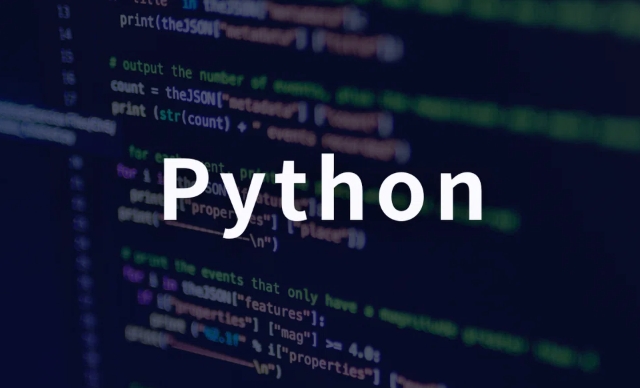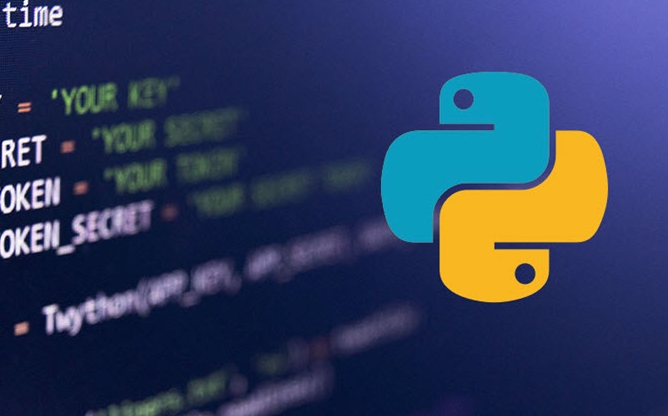Container Orchestration for Python Applications
The container orchestration for deploying Python applications is actually not complicated. The core is to make the container run stably and collaborate well. The first step is to package the application into a Docker image, write Dockerfile installation dependencies, copy code, and set up startup commands. Then choose the right orchestration tool. Kubernetes is the mainstream solution for multi-service scenarios, while Docker Compose, Nomad, or AWS's ECS/Fargate is more suitable for lightweight or stand-alone deployments. In terms of configuration management, it is recommended to split configuration files by environment and use ConfigMap and Secret to separate non-sensitive and sensitive information. Inter-service communication should be completed through the internal Service name to avoid exposing the public IP. Finally, automated deployment and health checks are crucial, including automatic restart (livenessProbe), automatic scaling (HPA), and integrated CI/CD pipelines to achieve continuous delivery, ensuring stable and efficient system operation.

Deploying Python applications with container orchestration is actually not that mysterious. To put it bluntly, let multiple containers run and cooperate well, and can automatically recover and expand capacity. For Python applications, especially web services (such as Django, Flask), using container orchestration can save a lot of effort in operation and maintenance.

Here are some common perspectives in actual use.
Containing your Python application is the first step
No matter what orchestration tool is used, the application must be packaged into a mirror. Python applications usually practice to write a Dockerfile in the root directory of the project, install dependencies, copy code, expose ports, and set startup commands.

To give a simple example:
FROM python:3.10-slim WORKDIR /app COPY requirements.txt . RUN pip install -r requirements.txt COPY . . CMD ["gunicorn", "app:app"]
This image can be built locally and run tests:

-
docker build -t my-python-app . -
docker run -p 8000:8000 my-python-app
After confirming that there is no problem, you can push it to the mirror repository (such as Docker Hub or private repository) for subsequent deployment.
Kubernetes is the mainstream choice, but don't ignore lightweight solutions
Speaking of container orchestration, Kubernetes (K8s for short) is almost the default option. It has powerful functions and supports advanced functions such as automatic scaling, rolling updates, and service discovery. It is suitable for multi-service and high-concurrency scenarios.
However, if you just want to deploy Python applications on stand-alone or small-scale clusters, you can consider a lighter solution, such as:
- Docker Compose : Suitable for local development and small deployments. By configuring YAML files, you can define services, networks, volume mounts, etc.
- Nomad : HashiCorp's scheduling tool is simpler than K8s and supports multiple task types.
- ECS/Fargate : If you are already using AWS, you can directly deploy containers with managed services without maintaining nodes by yourself.
Choose the right tool for different scenarios, and don’t use K8s as soon as you come up, sometimes it will increase the complexity.
Configuration files and service management should be clear
Whether it is K8s or Docker Compose, the configuration file is recommended to split by environment (dev, test, prod) to avoid hard-code sensitive information.
For example, in K8s, the recommended approach is:
- Use ConfigMap to store non-sensitive configurations (such as environment variables)
- Use Secret to store sensitive data such as passwords and keys
- References to these configurations in a Deployment or Pod definition
This can achieve "one-time build, multiple environment deployment" and reduce problems caused by configuration errors.
In addition, communication between services must be planned well. For example, the front-end adjustment back-end API can be accessed in the cluster through the Service name, and there is no need to expose the public IP.
Automated deployment and health checks must not be missing
The key to truly stable operation lies in automation and monitoring. Deployment does not mean that everything is good. You must also ensure:
- It can automatically restart when the application crashes (implemented through livenessProbe in K8s)
- Can automatically scale up and down according to load (HPA, based on CPU/memory or custom metrics)
- Try to automate the deployment process, such as CI/CD pipeline integration
Taking GitHub Actions K8s as an example, you can set up a workflow, automatically build the image after pushing to the main branch, push it to the repository, and trigger the K8s update deployment.
In this way, you only need to submit the code and leave the rest to the system for processing.
Basically that's it. Container orchestration sounds complicated, but in fact the core logic is "how to make containers run well." Although Python applications are not heavy, they are becoming more and more common under the microservice architecture. Mastering this deployment method will make your project easier to expand and maintain.
The above is the detailed content of Container Orchestration for Python Applications. For more information, please follow other related articles on the PHP Chinese website!

Hot AI Tools

Undress AI Tool
Undress images for free

Undresser.AI Undress
AI-powered app for creating realistic nude photos

AI Clothes Remover
Online AI tool for removing clothes from photos.

Clothoff.io
AI clothes remover

Video Face Swap
Swap faces in any video effortlessly with our completely free AI face swap tool!

Hot Article

Hot Tools

Notepad++7.3.1
Easy-to-use and free code editor

SublimeText3 Chinese version
Chinese version, very easy to use

Zend Studio 13.0.1
Powerful PHP integrated development environment

Dreamweaver CS6
Visual web development tools

SublimeText3 Mac version
God-level code editing software (SublimeText3)
 How to handle API authentication in Python
Jul 13, 2025 am 02:22 AM
How to handle API authentication in Python
Jul 13, 2025 am 02:22 AM
The key to dealing with API authentication is to understand and use the authentication method correctly. 1. APIKey is the simplest authentication method, usually placed in the request header or URL parameters; 2. BasicAuth uses username and password for Base64 encoding transmission, which is suitable for internal systems; 3. OAuth2 needs to obtain the token first through client_id and client_secret, and then bring the BearerToken in the request header; 4. In order to deal with the token expiration, the token management class can be encapsulated and automatically refreshed the token; in short, selecting the appropriate method according to the document and safely storing the key information is the key.
 Explain Python assertions.
Jul 07, 2025 am 12:14 AM
Explain Python assertions.
Jul 07, 2025 am 12:14 AM
Assert is an assertion tool used in Python for debugging, and throws an AssertionError when the condition is not met. Its syntax is assert condition plus optional error information, which is suitable for internal logic verification such as parameter checking, status confirmation, etc., but cannot be used for security or user input checking, and should be used in conjunction with clear prompt information. It is only available for auxiliary debugging in the development stage rather than substituting exception handling.
 What are Python type hints?
Jul 07, 2025 am 02:55 AM
What are Python type hints?
Jul 07, 2025 am 02:55 AM
TypehintsinPythonsolvetheproblemofambiguityandpotentialbugsindynamicallytypedcodebyallowingdeveloperstospecifyexpectedtypes.Theyenhancereadability,enableearlybugdetection,andimprovetoolingsupport.Typehintsareaddedusingacolon(:)forvariablesandparamete
 How to iterate over two lists at once Python
Jul 09, 2025 am 01:13 AM
How to iterate over two lists at once Python
Jul 09, 2025 am 01:13 AM
A common method to traverse two lists simultaneously in Python is to use the zip() function, which will pair multiple lists in order and be the shortest; if the list length is inconsistent, you can use itertools.zip_longest() to be the longest and fill in the missing values; combined with enumerate(), you can get the index at the same time. 1.zip() is concise and practical, suitable for paired data iteration; 2.zip_longest() can fill in the default value when dealing with inconsistent lengths; 3.enumerate(zip()) can obtain indexes during traversal, meeting the needs of a variety of complex scenarios.
 What are python iterators?
Jul 08, 2025 am 02:56 AM
What are python iterators?
Jul 08, 2025 am 02:56 AM
InPython,iteratorsareobjectsthatallowloopingthroughcollectionsbyimplementing__iter__()and__next__().1)Iteratorsworkviatheiteratorprotocol,using__iter__()toreturntheiteratorand__next__()toretrievethenextitemuntilStopIterationisraised.2)Aniterable(like
 Python FastAPI tutorial
Jul 12, 2025 am 02:42 AM
Python FastAPI tutorial
Jul 12, 2025 am 02:42 AM
To create modern and efficient APIs using Python, FastAPI is recommended; it is based on standard Python type prompts and can automatically generate documents, with excellent performance. After installing FastAPI and ASGI server uvicorn, you can write interface code. By defining routes, writing processing functions, and returning data, APIs can be quickly built. FastAPI supports a variety of HTTP methods and provides automatically generated SwaggerUI and ReDoc documentation systems. URL parameters can be captured through path definition, while query parameters can be implemented by setting default values for function parameters. The rational use of Pydantic models can help improve development efficiency and accuracy.
 Setting Up and Using Python Virtual Environments
Jul 06, 2025 am 02:56 AM
Setting Up and Using Python Virtual Environments
Jul 06, 2025 am 02:56 AM
A virtual environment can isolate the dependencies of different projects. Created using Python's own venv module, the command is python-mvenvenv; activation method: Windows uses env\Scripts\activate, macOS/Linux uses sourceenv/bin/activate; installation package uses pipinstall, use pipfreeze>requirements.txt to generate requirements files, and use pipinstall-rrequirements.txt to restore the environment; precautions include not submitting to Git, reactivate each time the new terminal is opened, and automatic identification and switching can be used by IDE.
 How to test an API with Python
Jul 12, 2025 am 02:47 AM
How to test an API with Python
Jul 12, 2025 am 02:47 AM
To test the API, you need to use Python's Requests library. The steps are to install the library, send requests, verify responses, set timeouts and retry. First, install the library through pipinstallrequests; then use requests.get() or requests.post() and other methods to send GET or POST requests; then check response.status_code and response.json() to ensure that the return result is in compliance with expectations; finally, add timeout parameters to set the timeout time, and combine the retrying library to achieve automatic retry to enhance stability.







